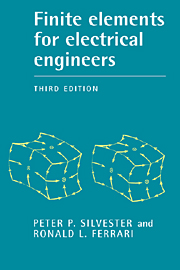Book contents
- Frontmatter
- Contents
- Preface to the third edition
- Preface to the first edition
- 1 Finite elements in one dimension
- 2 First-order triangular elements for potential problems
- 3 Electromagnetics of finite elements
- 4 Simplex elements for the scalar Helmholtz equation
- 5 Differential operators in ferromagnetic materials
- 6 Finite elements for integral operators
- 7 Curvilinear, vectorial and unbounded elements
- 8 Time and frequency domain problems in bounded systems
- 9 Unbounded radiation and scattering
- 10 Numerical solution of finite element equations
- Appendix 1 Calculations on simplex elements
- Appendix 2 Integration by parts, Green's theorems and Green's functions
- Appendix 3 Simplex element tables
- Appendix 4 Utility programs and style notes
- Appendix 5 Laboratory problems and exercises
- Index
7 - Curvilinear, vectorial and unbounded elements
Published online by Cambridge University Press: 05 June 2012
- Frontmatter
- Contents
- Preface to the third edition
- Preface to the first edition
- 1 Finite elements in one dimension
- 2 First-order triangular elements for potential problems
- 3 Electromagnetics of finite elements
- 4 Simplex elements for the scalar Helmholtz equation
- 5 Differential operators in ferromagnetic materials
- 6 Finite elements for integral operators
- 7 Curvilinear, vectorial and unbounded elements
- 8 Time and frequency domain problems in bounded systems
- 9 Unbounded radiation and scattering
- 10 Numerical solution of finite element equations
- Appendix 1 Calculations on simplex elements
- Appendix 2 Integration by parts, Green's theorems and Green's functions
- Appendix 3 Simplex element tables
- Appendix 4 Utility programs and style notes
- Appendix 5 Laboratory problems and exercises
- Index
Summary
Introduction
Triangular and tetrahedral elements as described in the foregoing chapters are widely used because any polygonal object can be decomposed into a set of simplexes without approximation. In fact, such decomposition can be carried out by computer programs without human intervention, since there do exist mathematical techniques guaranteed to produce correct decomposition into simplexes. Unfortunately, simplex elements also have some serious shortcomings. They do not lend themselves well to the modelling of curved shapes, so that the intrinsically high accuracy of high-order elements may be lost in rather rough geometric approximation. They use polynomial approximation functions throughout, so that fields containing very rapid variations, or even singularities, cannot be well approximated. A third disadvantage of scalar simplex elements is precisely that they do model scalar quantities; they are not well suited to describing vector fields. Finally, they are unable to model large (or infinite) regions economically; yet many field problems of electromagnetics are ‘open’, in the sense that the region of principal interest is embedded in an infinitely extending homogeneous exterior space.
Alternative element shapes and alternative types of approximating functions can avoid most of the problems inherent in the simplex elements. The use of so-called isoparametric elements, which have curved sides, can often alleviate the problems encountered in geometric modelling, by shaping the elements to fit the real geometry. Vector fields require vector approximating functions, and while their theory is neither so simple, nor quite so completely developed as for scalars, useful vectorvalued functions do exist.
Information
- Type
- Chapter
- Information
- Finite Elements for Electrical Engineers , pp. 269 - 343Publisher: Cambridge University PressPrint publication year: 1996
